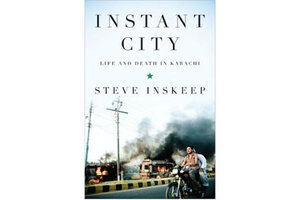Instant City: Life and Death in Karachi
NPR host Steve Inskeep writes about Karachi – a sprawling, striving, fractured city on the rise.

Instant City: Life and Death in Karachi
By Steve Inskeep.
Penguin
304 pp
One of the finest passages in Steve Inskeep’s informative, ambitious, chaotic, and sometimes glorious Instant City, which relates the epic story of Karachi, is a bravura evocation of the momentousness of Pakistan’s birth. “Cataclysmic events seemed to tilt the surface of the earth,” writes Inskeep, “raising the angle until human beings tumbled downhill into the city at the bottom of the slope. The partition of India was the greatest convulsion of all, tilting the ground on which millions of Indians stood. And Muslims began tumbling downward into Karachi’s reluctant embrace.”
That was in 1947. Overnight, Karachi’s population of approximately 400,000 doubled – hence the title of Inskeep’s book: "Instant City."
But Inskeep, a co-host of National Public Radio’s Morning Edition who has reported extensively from Pakistan, explains that there are other factors behind Karachi’s rapid rise. (Today its population is estimated at over 13 million). An instant city, which the author defines as “a metropolitan area that’s grown since 1945 at a substantially higher rate than the population of the country to which it belongs,” also boasts a high birth rate and extensive sprawl. Moreover, its supply of (usually rural) migrants is continuous. Karachi, which served as Pakistan’s capital until Islamabad was constructed for that purpose in the 1960s, fits the bill in every way.
Inskeep begins his account on December 28, 2009, with the bombing of a Shiite Muslim religious procession. This bloody incident serves as a segue into a discussion of largely unrelated subjects. The attack itself did not constitute a watershed (the author points out that “Shias were always being killed in Pakistan”), but it was followed by a fire that gutted the nearby Bolton Market. Because this historical district is located in a gentrifying area, it has long been considered prime real estate, and suspicions swirled among ordinary Pakistanis that the fire was arson on the part of powerful people who wanted to clear the land for their own construction projects.
Inskeep also uses the sectarian attack to travel backward in time and pinpoint reasons for the ethno-religious mess Karachi – and in many ways Pakistan as a whole – finds itself in today. He discusses the failure of Muhammad Ali Jinnah, Pakistan’s founder, to enshrine his largely secular outlook as the law of the land. In a country expressly intended to be Muslim in character, this opened the door to Islamization. Legally enforced Islamization not only changed the culture and marginalized non-Muslims, but deepened sectarian rifts between Muslims themselves – with minority communities such as Shiites and especially Ahmadis bearing the brunt of the suffering.
The other major conflict in Pakistan is ethnic, and Inskeep shows why it has played out in Karachi more than elsewhere. Because Karachi, located in southeastern Pakistan, served as a destination for hundreds of thousands of Mohajirs (migrants) from India during the 1947 partition, friction arose with the different ethnic groups already inhabiting the city. Soon, political parties were formed on ethnic lines, and competition over land and (scarce) government services took on an ethnic hue.
It’s not all bad news. Plunging into the immensity of Karachi and its mushrooming population, Inskeep finds individuals selflessly dedicated to improving life in their beleaguered city. Consider 80-plus Abdul Sattar Edhi, owner (and still active director) of a trusty ambulance service, and Dr. Seemin Jamali, indefatigable head of the emergency ward at Jinnah Hospital. Or take activists such as Perween Rahman, who works on slum development, and Amber Alibhai, who campaigns on behalf of the environment (and whose colleague Nisar Baloch was murdered for trying to prevent further housing encroachment on Gutter Baghicha national park). Husband and wife team Adnan and Mahboob Asdar also come to mind. He is a corporate executive, she is an architect; their commendable joint ambition is to create affordable housing for the poor.
Admittedly, this book’s structure could have used some tightening. "Instant City" starts out focused – using an attack on Shiites as a launching pad for a discussion of Karachi’s ethno-religious ills – but soon begins to expand in all directions. This makes it a bit unwieldy, but simultaneously attests to the author’s refusal to be trammeled by conventional style or form. In this respect, the book is reminiscent of Karachi itself. A recurring theme of "Instant City," one that paradoxically elicits admiration for Karachi’s resourceful inhabitants even as it induces a feeling of helplessness regarding their disorderly actions, is that Karachi’s growth has consistently outpaced – and thereby often rendered useless – city planners’ designs.
Rayyan Al-Shawaf is a writer and freelance reviewer based in Beirut, Lebanon.
